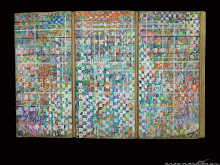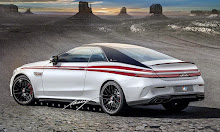Continuing my series of vintage cars I photographed in the early 1980s, today I present three manufacturers among the last of the domestic "Independents," Packard, Studebaker and Hudson. Pictured in canary yellow and black is a 1956 Clipper sedan by Packard, the last year that Packard sold cars using its own bodyshells. Clipper was now its own division, although it was clearly a junior Packard. I'm sure most people didn't understand, or appreciate, this difference, as the Clipper nameplate had been used by Packard since the early 1940s. There is a long, sad story of Packard's last days, first being bought by Studebaker and eventually dropped after building badge-engineered Studes for '57 and '58, but I won't go into it now. The last "true" Packards, the '55s and '56s were magnificent cars, whether they were the juniors, the Clippers, or the seniors, the 400s, Patricians and Caribbeans.
The '56 Packards featured push-button automatic transmissions, visible through the steering wheel, just under the radio. Notice the divided leather front seats; even a bottom-of-the-range Packard was a quality automobile.
The "Clipper" script on the front of the hood is one of the most distinctive uses of typography on a mid-century automobile. Stretching seven connected letters across almost the width of the car was gutsy, artistic and dramatic. The Clipper's "ship's wheel" logo is centered in the grille below it, and the bow-shaped grille itself, a modern interpretation of Packard's classic "yoke" radiator shape.
Many, many times in its long and storied history, Studebaker fielded dramatic and elegantly styled cars. This is the rear window of a 1937 Dictator business coupe. Art Deco meets Streamline styling and equals distinction and presence in spades.
Another Studebaker coupe that blew the competition into the weeds in 1947: "The first by far with a post war car!" proclaimed the company's advertisements. This wraparound rear window of the Starlight coupe was the exclamation point for the entire lineup of futuristic automobiles designed primarily by Virgil Exner, though credited to Raymond Loewy at the time as it was his name on the design firm's letterhead and in the newspapers. There was nothing like it then, or now.
The Hudson Italia, a halo car built for Hudson by an Italian firm named Touring. This was a compact "personal luxury coupe" a good ten years ahead of its time. Only 25 examples of this car were built, all in the same cream exterior with red and white leather interior as this car was. Click on the links in this caption to read more about this fascinating automaker.
The red-and-white leather bucket seats included lumbar supports, and the interior boasted flow-through ventilation, creature comforts ahead of their time. Also visible in this view are the aircraft-inspired door openings cut high into the low roof for ease of entrance. I don't seem to have gotten a shot of the car's most interesting design detail—the taillights were housed in three individual chrome "tubes" on the rear sides of the car, looking for all the world like jet exhausts. Many manufacturers seized upon the postwar jets' styling cues, notably DeSoto and Mercury, but none as stunningly as Hudson on their Italia.
As with all of the images in this old car show series, these photographs were taken with black-and-white film and have been colorized in a whimsical manner using Photoshop; all are clickable to enlarge.










Wonderful!!
ReplyDeleteSo were yellow and black the colors of the Clipper or did you choose those colors when you colorized?
Studebaker often had very cool cars, particularly two-doors -- CA (I've still not found the April issue -- they used to be much more reliable on being out on the 1st) did a piece a few issues ago about a Studebaker club coupe from 39/40 that was really a beautiful car. Certainly the 47 and on Starlight coupe was startling on many levels (which way is it going?). It got even more startling with the 50s and the jet nose.
I'm sure you've seen the prototype of the 4-door Italia that was thought of as a future Hudson which never came to pass, of course. I think Frank Spring kept it as his personal car and I believe it still exists.
That Clipper is quite magnificent -- the one you show is the top of the line Clipper. Packard used the pushbuttons just that one year and mounted them on the steering column so that the driver could operate them without removing his/her hand from the steering wheel. The one drawback was that they were, I believe, electrically operated, so that if your battery was dead you couldn't get the car out of Park. I think this was the same problem with the Edsel's Tele-Touch wheel=mounted pushbuttons. Chrysler used actual metal connections that were very reliable -- I've never heard of any problems with them.
Paul, NYC
G'morning Paul! I think the Clipper was black and white, but I didn't write any notes about it. I've seen a yellow and black one in CA, or HCC, so I thought I'd go with it for the colorization. I don't think I realized how rare the Italia was when I photographed it either. I knew what it was, but I'm sure I didn't know there were only 25 ever made or I would have photographed it from every angle. The rear design is really the best angle.
ReplyDeleteWhatever is left of Suderbacker is now in some minuscule plant down in Mexico.
ReplyDeleteGN CASEY GN
ReplyDeleteGRANNY